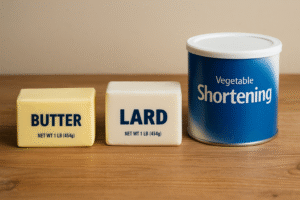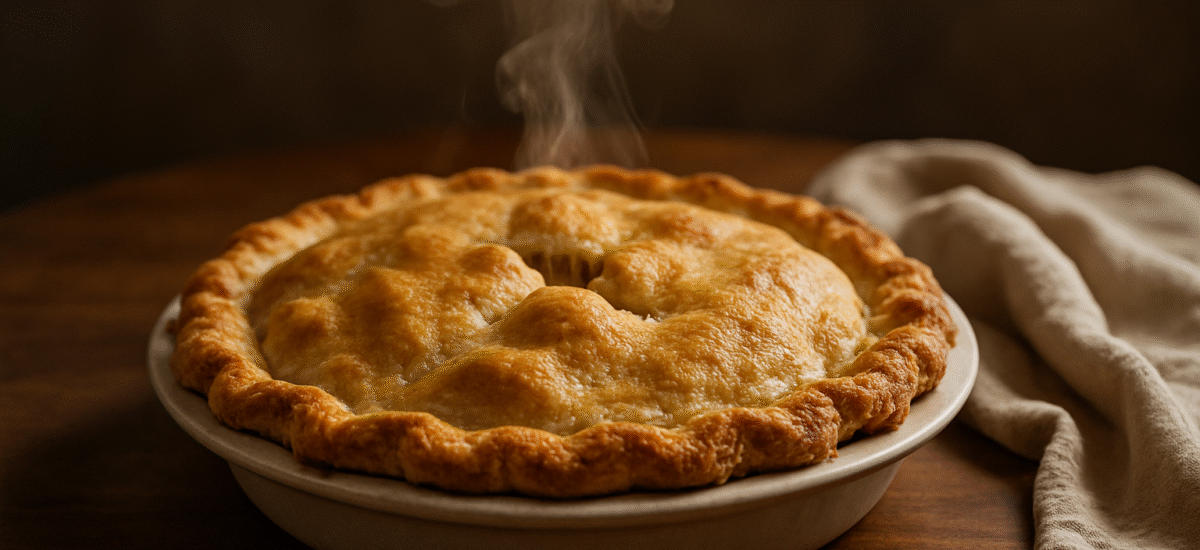Pie Crust Fats: Why I Choose Butter and Lard Over Shortening

When it comes to baking the perfect pie crust, the type of fat you use matters—a lot. While shortening has had its moment in many classic recipes, I’ve come to love (and trust!) a more traditional combination: butter and lard.
As a home cook who cares about both flavor and health, and someone who’s always experimenting with ingredients in the kitchen, I wanted to share a little behind-the-scenes on why I reach for natural fats—and skip the hydrogenated stuff.
🧈 Butter: Flavor You Can’t Fake
Butter gives pie crust its rich taste and golden finish. It’s a natural fat made from cream, offering nutrients like vitamins A and D, and it hasn’t been tampered with through heavy processing. The flavor alone is worth it—but it also adds some tenderness to the crust.
-
Pros:
-
Natural fat: Butter is a natural fat made from cream, offering a rich flavor and a desirable texture, especially in baked goods.
-
Less processed: It doesn’t undergo hydrogenation, which means it doesn’t have trans fats, unlike some processed fats.
-
Nutritional value: Butter provides vitamins like A, D, E, and K, as well as butyrate, a short-chain fatty acid that can support gut health.
-
-
Cons:
-
Saturated fat: Butter does contain saturated fat, which, when consumed in large amounts, can contribute to increased LDL (“bad”) cholesterol levels. Moderation is key here.
-
🐖 Lard: The Flaky Secret
Lard (yes, the real deal from pork fat) creates those beautifully flaky layers we all crave in a crust. It’s high in monounsaturated fats—the same kind you find in olive oil—which makes it a healthier choice than many realize. Bonus: it’s shelf-stable and has a clean, neutral flavor.
-
Pros:
-
Animal fat, less processed: Lard is rendered from pork fat, making it a natural fat that hasn’t been hydrogenated or altered in the same way as processed fats.
-
High in monounsaturated fat: Lard contains a decent amount of monounsaturated fats (the “healthy” fats also found in olive oil), which can be heart-healthy when consumed in moderation.
-
Flaky texture: Lard is highly prized in baking, especially for pie crusts, due to its ability to create a super flaky texture.
-
-
Cons:
-
Saturated fat content: While lard has less saturated fat than butter, it’s still high in fat overall. However, it contains more monounsaturated fat than butter, making it a bit healthier in terms of fat composition.
-
Animal-based: Some people avoid animal products for ethical or dietary reasons.
-
🚫 Why I Skip Hydrogenated Fats
Shortening was once a go-to for flakiness, but it’s highly processed and can contain trans fats, which have been linked to heart issues. Even brands labeled “trans fat-free” may still contain small amounts. I prefer to avoid it altogether in favor of whole, natural fats I feel good about using.
-
Pros:
-
Long shelf life: Hydrogenated fats, like shortening, have a long shelf life and are stable at room temperature, which makes them useful for commercial baking.
-
Texture: Hydrogenated fats create a very flaky texture in pie crusts and other baked goods.
-
-
Cons:
-
Trans fats: The process of hydrogenation creates trans fats, which are associated with increased risk of heart disease and other health issues. Even though many brands now advertise being “trans fat-free,” they can still contain trace amounts.
-
Highly processed: Hydrogenated fats are more processed than natural fats, and some people avoid them due to their potential health risks.
-
Healthier Options:
-
Butter and Lard are both more natural and less processed than hydrogenated fats like shortening. When consumed in moderation, these fats can be a part of a balanced diet.
-
Lard has the benefit of a higher monounsaturated fat content, which may make it a slightly healthier choice compared to butter in terms of fat composition.
-
Butter provides flavor and some beneficial nutrients but should be consumed in moderation due to its higher saturated fat content.
My Opinion:
Both butter and lard are healthier choices than hydrogenated fats (like shortening). They’re more natural and less processed, and they offer a better fat profile. For a healthier approach, you might want to balance your intake of both and use them in moderation, depending on the recipe. In terms of baking, using butter and lard together can give you the best of both worlds—flavor from the butter and flakiness from the lard.
🥄 My Favorite Combo
For my no-fail pie crust, I use a mix of butter for flavor and lard for texture. The result? A crust that’s golden, tender, and beautifully flaky—without relying on artificial ingredients.
If you’re curious or have your own fat preferences when baking, I’d love to hear from you! 💙
💬 Leave a comment and share what works for you. It’s always great to learn from other foodies!
References:
-
Mayo Clinic on Trans Fats
The Mayo Clinic explains that trans fats raise LDL (“bad”) cholesterol and lower HDL (“good”) cholesterol, increasing the risk of heart disease and stroke. Trans fats are commonly found in partially hydrogenated oils, which are present in many shortenings. Mayo Clinic -
American Heart Association’s View
The American Heart Association states that trans fats not only raise bad cholesterol levels but also lower good cholesterol levels. Consuming trans fats increases the risk of developing heart disease and stroke. www.heart.org -
WebstaurantStore on Lard
According to WebstaurantStore, lard contains less saturated fat than butter and, unlike vegetable shortening, has no trans fats. Lard produces crumbly, flaky pie crusts and tender, moist baked goods. WebstaurantStore -
Nutrition Over Easy on Lard and Butter
Nutrition Over Easy highlights that lard contains more monounsaturated fats than saturated fats and has more omega-3 fatty acids per ounce than butter. Butter, while containing more cholesterol, is still a natural fat that can be part of a healthy diet when used in moderation. Nutrition Over Easy -
King Arthur Baking on Butter vs. Shortening
King Arthur Baking discusses how butter provides superior flavor in pie crusts, while shortening contributes to flakiness. They suggest that a combination of both can yield the best results, but emphasize the natural qualities of butter. King Arthur Baking
.

